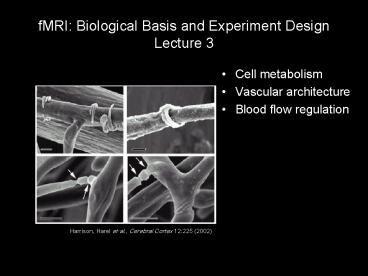fMRI: Biological Basis and Experiment Design Lecture 3 - PowerPoint PPT Presentation
Title:
fMRI: Biological Basis and Experiment Design Lecture 3
Description:
Fox and Raichle. Surprise finding suggests that neuronal activity elicits ... half the blood volume is in intracortical veins and arteries (2% gray matter vol. ... – PowerPoint PPT presentation
Number of Views:70
Avg rating:3.0/5.0
Title: fMRI: Biological Basis and Experiment Design Lecture 3
1
fMRI Biological Basis and Experiment
DesignLecture 3
- Cell metabolism
- Vascular architecture
- Blood flow regulation
Harrison, Harel et al., Cerebral Cortex 12225
(2002)
2
Oxidative vs. anaerobic metabolism
mitochondrion
http//personal.nbnet.nb.ca/trevgall/biology/
Nucleus
3
Fox and Raichle
- Surprise finding suggests that neuronal activity
elicits anaerobic metabolism
CBF
CMRO2
OEF
Fox and Raichle, 1986 ? CBF gtgt ? CMRO2
4
The Magistretti Hypothesis
- Astrocytes anaerobically metabolize glucose to
lactate - Neurons aerobically metabolize lactate/pyruvate
Magistretti (2000) Brain Research 886108
5
Neurons and astrocytes are cells
Astrocyte
Neuron
32 ATP
32 ATP
6
Magistretti hypothesis an explanation for Fox
and Raichle
Astrocyte
glucose
Neuron
2 LAC 2 ATP
32 ATP
7
Metabolism in astrocytes and neurons
Attwell Laughlin (2001). JCBFM 21 1133-1145.
8
Evidence for compartmentalization of metabolism
- Kasischke, K. A., Vishwasrao, H. D., Fisher, P.
J., Zipfel, W. R. Webb, W. W. (2004). Neural
activity triggers neuronal oxidative metabolism
followed by astrocytic glycolysis. Science, 305,
99-103.
9
Brains are not muscles
Pediatric patient (with fungal infection of liver)
Adult (showing scar tissue following hernia
repair)
18-FDG PET images from Abouzied et al. (2005). J.
Nuc. Med. Tech. 33(3)145
10
Neurovascular coupling why energy budgets and
oxidative metabolism matter
Astrocyte Inc Ca, uptake of glutamate --gt
(release of NO, EET), increased glucose
metabolism (non-oxydative)?
Interneuron - inc Caeven w/o spikes -
release of NO, EETs --gt dilation -
release of NPY, SOM(?) --gt contstriction -
inc. glc metabolism?
Neuron - inc Ca when spiking - release of
NO, EETs - inc. glc metabolism (oxidative)?
11
Harrison, Harel et al., Cerebral Cortex 12225
(2002)
12
Harrison, Harel et al., Cerebral Cortex 12225
(2002)
100?m
13
50?m
14
On the scale of a voxel
Human temporal cortex
- Blood is supplied to and drained from the cortex
by the pial network - 100 500 micron diameter
- half the blood volume is in intracortical veins
and arteries (2 gray matter vol.) - 10 50 micron diameter
- diameter depends on depth
- half the blood volume is in the capillary
network (2 gray matter vol.) - 8 micron diameter
- density correlates with neural demand
- White matter is supplied by transcortical
arteries and veins
375 ?m
Reina de la Torre et al (1998) Anatomical Record
25187
15
The Plumbers and the Electricians
- There is no such thing as constant flow
- Pulse
- Vasculature is highly responsive can
autoregulate - The vascular network is not a fixed entity
- Flow can switch directions in small vessels and
capillaries - Capillaries can grow to match metabolic demand
- Bottom-up regulation is more practical than
top-down
16
Balloon Model, Part I CBF and CBV
- CBF cerebral blood flow
- increased CBF increases signal strength
- CBV cerebral blood volume
- increased venous blood volume decreases signal
strength
Fout(t)
Fin(t)
17
(No Transcript)
18
Filling the balloon
where ?0 is mean transit time through balloon,
resting state ?v is mean transit time through
expanded balloon v(t) is volume of balloon
Fout(t)
Fin(t)































